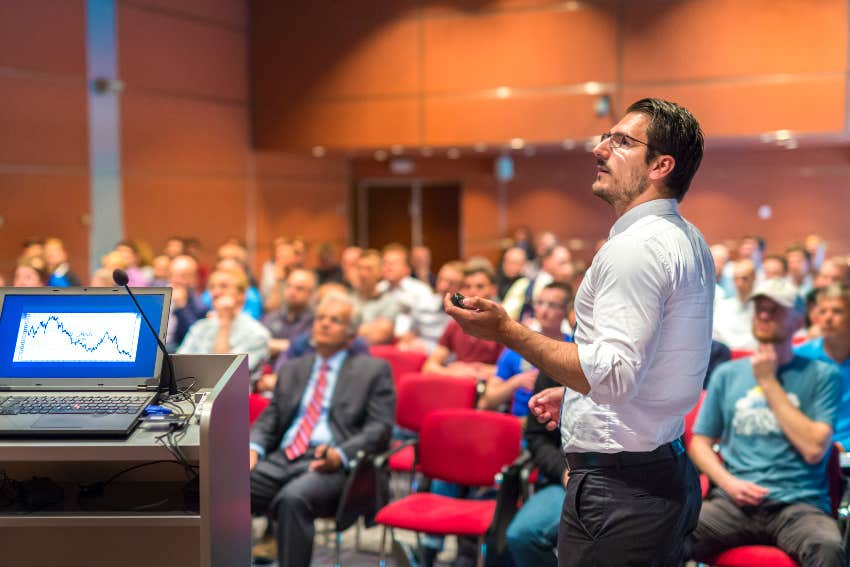The Simple Public Speaking Trick To Command Any Room, Says Psychologist
The easiest way to speak powerfully in public.
 Brooke Cagle | Unsplash
Brooke Cagle | Unsplash Everyone loves policing women's language. From telling us not to use rising terminations (you know, when your sentences all kind of go up at the end? Like a question?) to telling us not to use hedging language (words that soften what you're saying to make you seem "nicer" and more "likable," instead of "angry" — for example, "Maybe it's just me, and this is just an idea, but do you think maybe we should try ____?"), the internet is full of advice on how women "should" speak.
The obvious solution isn't that women should have to change how they talk — it's that people should listen to what women say instead of how they say it. But the fact remains that people judge us based on how we talk, especially in public speaking.
The public speaking trick to command any room: Speak more slowly.
 fizkes / Shutterstock
fizkes / Shutterstock
You can start using this trick to increase how powerful you appear to others just by slowing down and speaking more thoughtfully and deliberately. According to the Stanford Graduate School of Business professor Richard Lee Cox Braden, powerful people speak more slowly. This is true for several reasons.
Power is related to status, and people with status know that they won't be interrupted when they pause, take a breath, or speak slowly.
Lower-status people, on the other hand, talk quickly because they feel like they have a limited amount of time to cram in what they have to say. Their figurative "talking stick" could be taken away at any moment.
Another reason powerful people speak slower is that powerful people have (or pretend to have) confidence. Talking quickly is a sign of nervousness, anxiety, or uncertainty, unconsciously indicating a lack of confidence.
This is especially apparent during public speaking, which gives pretty much everyone stage fright. Who here hasn't been to at least one presentation that was delivered so quickly you couldn't understand it?
This was certainly true for PepsiCo CEO Indra Nooyi in her early career. But today she speaks at a leisurely 150 words per minute, which is about the same pace as your average audiobook narration.
Carmine Gallo, the author of Talk Like TED: The 9 Public Speaking Secrets of the World's Top Minds, suggests that the ideal presentation be delivered at about 190 words per minute, depending on your personality and style. (For comparison, an auctioneer speaks at 250 words per minute.)
 Matej Kastelic / Shutterstock
Matej Kastelic / Shutterstock
Finally, because it's harder to understand someone who's talking quickly than someone who speaks more deliberately, your listeners will have to work harder to follow your ideas if you're a fast talker.
This could signal that you don't think what you have to say is important or that you don't care how well your words are understood. So, if you want to come across as more powerful, talk slower.
Try to match the pace of your audiobooks. Speak slowly enough that you can consciously process each word as you say it.
Practice now by re-reading the last sentence out loud and think about each word as you say it. It will feel ridiculous, but it will work wonders.
Eva Glasrud has a Masters Degree in psychology from Stanford University and is and education consultant at Paved With Verbs. She also runs The Happy Talent, a blog about social and leisure skill development.

